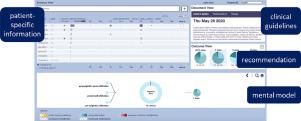当前位置:
X-MOL 学术
›
Comput. Graph.
›
论文详情
Our official English website, www.x-mol.net, welcomes your
feedback! (Note: you will need to create a separate account there.)
A Visual Approach to Explainable Computerized Clinical Decision Support
Computers & Graphics ( IF 2.5 ) Pub Date : 2020-10-01 , DOI: 10.1016/j.cag.2020.06.004 Juliane Müller , Matthaeus Stoehr , Alexander Oeser , Jan Gaebel , Marc Streit , Andreas Dietz , Steffen Oeltze-Jafra
Computers & Graphics ( IF 2.5 ) Pub Date : 2020-10-01 , DOI: 10.1016/j.cag.2020.06.004 Juliane Müller , Matthaeus Stoehr , Alexander Oeser , Jan Gaebel , Marc Streit , Andreas Dietz , Steffen Oeltze-Jafra

|
Abstract Clinical Decision Support Systems (CDSS) provide assistance to physicians in clinical decision-making. Based on patient-specific evidence items triggering the inferencing process, such as examination findings, and expert-modeled or machine-learned clinical knowledge, these systems provide recommendations in finding the right diagnosis or the optimal therapy. The acceptance of, and the trust in, a CDSS are highly dependent on the transparency of the recommendation’s generation. Physicians must know both the key influences leading to a specific recommendation and the contradictory facts. They must also be aware of the certainty of a recommendation and its potential alternatives. We present a glyph-based, interactive multiple views approach to explainable computerized clinical decision support. Four linked views (1) provide a visual summary of all evidence items and their relevance for the computation result, (2) present linked textual information, such as clinical guidelines or therapy details, (3) show the certainty of the computation result, which includes the recommendation and a set of clinical scores, stagings etc., and (4) facilitate a guided investigation of the reasoning behind the recommendation generation as well as convey the effect of updated evidence items. We demonstrate our approach for a CDSS based on a causal Bayesian network representing the therapy of laryngeal cancer. The approach has been developed in close collaboration with physicians, and was assessed by six expert otolaryngologists as being tailored to physicians’ needs in understanding a CDSS.
中文翻译:

可解释的计算机化临床决策支持的可视化方法
摘要 临床决策支持系统 (CDSS) 为医生的临床决策提供帮助。基于触发推理过程的患者特定证据项目,例如检查结果和专家建模或机器学习的临床知识,这些系统提供建议以找到正确的诊断或最佳治疗。CDSS 的接受和信任在很大程度上取决于推荐生成的透明度。医生必须知道导致特定建议的关键影响和相互矛盾的事实。他们还必须了解建议及其潜在替代方案的确定性。我们提出了一种基于字形的交互式多视图方法来提供可解释的计算机化临床决策支持。四个链接视图 (1) 提供所有证据项及其与计算结果相关性的可视化摘要,(2) 提供链接的文本信息,例如临床指南或治疗细节,(3) 显示计算结果的确定性,包括推荐和一组临床评分、分期等,并且 (4) 促进对推荐生成背后的推理的引导调查,并传达更新的证据项目的效果。我们展示了我们的基于因果贝叶斯网络的 CDSS 方法,代表了喉癌的治疗。该方法是与医生密切合作开发的,并由六位耳鼻喉科专家评估为适合医生理解 CDSS 的需求。(2) 提供链接的文本信息,例如临床指南或治疗细节,(3) 显示计算结果的确定性,其中包括推荐和一组临床评分、分期等,以及 (4) 促进引导调查推荐生成背后的推理以及传达更新的证据项目的效果。我们展示了我们的基于因果贝叶斯网络的 CDSS 方法,代表了喉癌的治疗。该方法是与医生密切合作开发的,并由六位耳鼻喉科专家评估为适合医生理解 CDSS 的需求。(2) 提供链接的文本信息,例如临床指南或治疗细节,(3) 显示计算结果的确定性,其中包括推荐和一组临床评分、分期等,以及 (4) 便于引导调查推荐生成背后的推理以及传达更新的证据项目的效果。我们展示了我们的基于因果贝叶斯网络的 CDSS 方法,代表了喉癌的治疗。该方法是与医生密切合作开发的,并由六位耳鼻喉科专家评估为适合医生理解 CDSS 的需求。其中包括推荐和一组临床评分、分期等,以及 (4) 促进对推荐生成背后的推理的引导调查,并传达更新的证据项目的效果。我们展示了我们的基于因果贝叶斯网络的 CDSS 方法,代表了喉癌的治疗。该方法是与医生密切合作开发的,并由六名耳鼻喉科专家评估为适合医生理解 CDSS 的需求。其中包括推荐和一组临床评分、分期等,以及 (4) 促进对推荐生成背后的推理的引导调查,并传达更新的证据项目的效果。我们展示了我们的基于因果贝叶斯网络的 CDSS 方法,代表了喉癌的治疗。该方法是与医生密切合作开发的,并由六位耳鼻喉科专家评估为适合医生理解 CDSS 的需求。
更新日期:2020-10-01
中文翻译:

可解释的计算机化临床决策支持的可视化方法
摘要 临床决策支持系统 (CDSS) 为医生的临床决策提供帮助。基于触发推理过程的患者特定证据项目,例如检查结果和专家建模或机器学习的临床知识,这些系统提供建议以找到正确的诊断或最佳治疗。CDSS 的接受和信任在很大程度上取决于推荐生成的透明度。医生必须知道导致特定建议的关键影响和相互矛盾的事实。他们还必须了解建议及其潜在替代方案的确定性。我们提出了一种基于字形的交互式多视图方法来提供可解释的计算机化临床决策支持。四个链接视图 (1) 提供所有证据项及其与计算结果相关性的可视化摘要,(2) 提供链接的文本信息,例如临床指南或治疗细节,(3) 显示计算结果的确定性,包括推荐和一组临床评分、分期等,并且 (4) 促进对推荐生成背后的推理的引导调查,并传达更新的证据项目的效果。我们展示了我们的基于因果贝叶斯网络的 CDSS 方法,代表了喉癌的治疗。该方法是与医生密切合作开发的,并由六位耳鼻喉科专家评估为适合医生理解 CDSS 的需求。(2) 提供链接的文本信息,例如临床指南或治疗细节,(3) 显示计算结果的确定性,其中包括推荐和一组临床评分、分期等,以及 (4) 促进引导调查推荐生成背后的推理以及传达更新的证据项目的效果。我们展示了我们的基于因果贝叶斯网络的 CDSS 方法,代表了喉癌的治疗。该方法是与医生密切合作开发的,并由六位耳鼻喉科专家评估为适合医生理解 CDSS 的需求。(2) 提供链接的文本信息,例如临床指南或治疗细节,(3) 显示计算结果的确定性,其中包括推荐和一组临床评分、分期等,以及 (4) 便于引导调查推荐生成背后的推理以及传达更新的证据项目的效果。我们展示了我们的基于因果贝叶斯网络的 CDSS 方法,代表了喉癌的治疗。该方法是与医生密切合作开发的,并由六位耳鼻喉科专家评估为适合医生理解 CDSS 的需求。其中包括推荐和一组临床评分、分期等,以及 (4) 促进对推荐生成背后的推理的引导调查,并传达更新的证据项目的效果。我们展示了我们的基于因果贝叶斯网络的 CDSS 方法,代表了喉癌的治疗。该方法是与医生密切合作开发的,并由六名耳鼻喉科专家评估为适合医生理解 CDSS 的需求。其中包括推荐和一组临床评分、分期等,以及 (4) 促进对推荐生成背后的推理的引导调查,并传达更新的证据项目的效果。我们展示了我们的基于因果贝叶斯网络的 CDSS 方法,代表了喉癌的治疗。该方法是与医生密切合作开发的,并由六位耳鼻喉科专家评估为适合医生理解 CDSS 的需求。









































 京公网安备 11010802027423号
京公网安备 11010802027423号